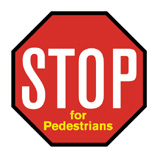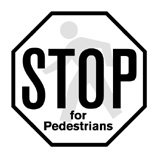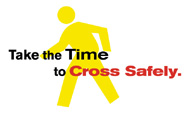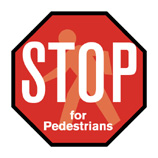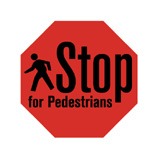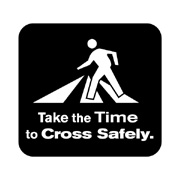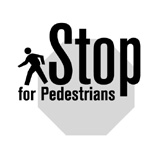Campaign Materials
For a complete list of campaign materials, please see the matrix on page 100.
TV PSAs
These PSAs can be found on both the beta tape and Data CD2 in the Pedestrian Safety Campaign Planner materials.
This campaign includes 2 driver-targeted TV PSAs:
 |
Driver/Child Crossing :30 Highlights a crucial concern for pedestrian safety: Drivers making left or right turns at intersections may not remember to look for pedestrians crossing. |
 |
Driver/Young Girl :30 Makes a hard-hitting emotional appeal to drivers: Look out for pedestrians - the lives of others are in your path. Also included are 2 pedestrian-targeted TV PSAs: |
Also included are 2 pedestrian-targeted TV PSAs:
 |
Pedestrian/Signals :30 Uses film footage, voiceover and animated text to explain the pedestrian crossing signals. |
 |
Pedestrian/Night Visibility :15 Shows a firefighter at work and walking in casual clothing at night, making use of reflective materials and emphasizing the importance of being visible when walking in the dark. |
Radio PSAs
The following radio PSAs were developed for the Pedestrian Safety Campaign and are included in the audio CD that is part of the campaign materials:
Good Driver :30
Sounds of cars zooming by and other road noise. Then a young man's voice. He sounds sincere. "I'm a good driver. I look for cars. I pay attention." Sound of tires screeching, a young girl's scream, and shattering windshield. Then silence. Music becomes more somber. The driver is clearly emotional as he says: "I should have seen the little girl in the crosswalk."
Narrator: "Please, look for pedestrians. Stop for them. Think of the impact you can make. A message from the Federal Highway Administration."
Young Girl :30
Sounds of traffic zooming by. Above the noise, a young girl's voice. She is clearly upset. "Why was that driver in such a hurry? He was looking for other cars as he turned the corner. He wasn't looking for my mom in the crosswalk." Sound of tires screeching, a scream, and shattering windshield. Then silence. Music becomes more somber. Full of anguish, the girl continues, "I really miss her. . ."
Narrator: "Please, look for pedestrians. Stop for them. Think of the impact you can make. A message from the Federal Highway Administration."
Young Girl-Multiple Threat :30
Sounds of traffic zooming by. Above the noise, a young girl's voice. She is clearly upset. "Why was that driver in such a hurry? He saw the car in the other lane stop and he decided to go around it. He wasn't looking for my mom in the crosswalk." Sound of tires screeching, a scream, and shattering windshield. Then silence. Music becomes more somber. "I really miss her. . ."
Narrator: "Please, look for pedestrians. When a car stops in front of you, slow down and be prepared to stop. Someone may be crossing the street. Think of the impact you can make. A message from the Federal Highway Administration."
Distracted Teen :30
Sounds of traffic zooming by then a young male voice. "We were just driving to school. Yeah, the music was loud and we were all talking. I thought I had everything under control." Sound of tires screeching, a scream, and shattering windshield. The young male continues, clearly emotional. "Until I hit that kid in the crosswalk."
Narrator: "Please, look for pedestrians. Stop for them. Think of the impact you can make. A message from the Federal Highway Administration."
Instant :30
A young mom's voice, starts out sweet and turns very emotional. "In an instant, my son could make anyone smile. In an instant, he was gone. The driver was looking for other cars, but he didn't watch out for my son crossing the street. Imagine, in the time it takes to stop for someone in the crosswalk, you could save a life... or change yours forever."
Narrator: "A message from the Federal Highway Administration."
Share the Road :15
Sounds of several cars rushing by, then a young woman's voice. "I walk and you drive. So let's make a deal. I'll watch for you - and cross the street safely. You watch for me - and stop. Think of the impact we can make."
Narrator: "A message from the Federal Highway Administration."
Print PSAs
There are many ways to use and place print PSAs. A variety of schools, businesses, communities, associations and religious groups publish newsletters and are willing to run PSAs. Most major magazines and newspapers offer PSA placement to some extent. Many times they will keep them on hand to fill advertisement space when an advertiser cancels an ad at the last minute.
Companies and organizations sometimes donate ad space in their newsletters, brochures, or other print materials that may be filled with one of the print PSAs. Creative possibilities for PSA placement include bus signs, paycheck stuffers for local businesses, billboards, store flyers, insurance company bill stuffers, and palm cards for law enforcement and crossing guards.
Call your nearby publications and ask whether they place PSAs, and if so, how they would like for you to deliver them. In most cases, you will provide electronic files. You will need to ask which file format they prefer, and then provide those files on a CD. The CDs in this kit contain QuarkXPress files, the file type most often preferred by print publications. Some may prefer to print the PSAs in black and white as opposed to full-color. If black and white is required, have a graphic designer convert the full color PSA files to black and white files before delivery to the publications.
You may have graphic designer or printing firm add your organization or coalition logo to the PSAs prior to delivery to the publications. The text "sponsor logo here" should be removed prior to delivery.

File is located on Data CD1 in the folder FHWA PRINT PSAs/DRIVER PSAs on page 2 of the Quark document DRIVER_PRINT_PSAs.
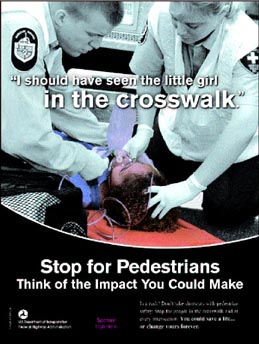
File is located on Data CD1 in the folder FHWA PRINT PSAs/DRIVER PSAs on page 3 of the Quark document DRIVER_PRINT_PSAs.

File is located on Data CD1 in the folder FHWA PRINT PSAs/DRIVER PSAs on page 4 of the Quark document DRIVER_PRINT_PSAs.

File is located on Data CD1 in the folder FHWA PRINT PSAs/DRIVER PSAs on page 5 of the Quark document DRIVER_PRINT_PSAs.

File is located on Data CD1 in the folder FHWA PRINT PSAs/DRIVER PSAs on page 6 of the Quark document DRIVER_PRINT_PSAs.

File is located on Data CD1 in the folder FHWA PRINT PSAs/DRIVER PSAs on page 7 of the Quark document DRIVER_PRINT_PSAs.
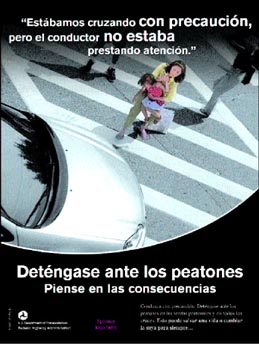
File is located on Data CD1 in the folder FHWA PRINT PSAs/DRIVER PSAs on page 8 of the Quark document DRIVER_PRINT_PSAs.

File is located on Data CD1 in the folder FHWA PRINT PSAs/DRIVER PSAs on page 9 of the Quark document DRIVER_PRINT_PSAs.

File is located on Data CD1 in the folder FHWA PRINT PSAs/PEDESTRIAN PSAs on page 2 of the Quark document PEDESTRIAN_PRINT_PSAs.

File is located on Data CD1 in the folder FHWA PRINT PSAs/PEDESTRIAN PSAs on page 3 of the Quark document PEDESTRIAN_PRINT_PSAs.
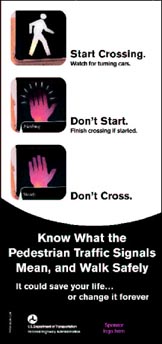
File is located on Data CD1 in the folder FHWA PRINT PSAs/PEDESTRIAN PSAs on page 4 of the Quark document PEDESTRIAN_PRINT_PSAs.

File is located on Data CD1 in the folder FHWA PRINT PSAs/PEDESTRIAN PSAs on page 5 of the Quark document PEDESTRIAN_PRINT_PSAs.

File is located on Data CD1 in the folder FHWA PRINT PSAs/PEDESTRIAN PSAs on page 6 of the Quark document PEDESTRIAN_PRINT_PSAs.
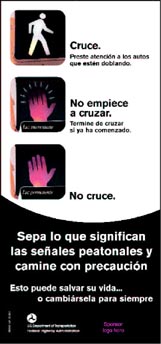
File is located on Data CD1 in the folder FHWA PRINT PSAs/PEDESTRIAN PSAs on page 7 of the Quark document PEDESTRIAN_PRINT_PSAs.

File is located on Data CD1 in the folder FHWA PRINT PSAs/PEDESTRIAN PSAs on page 8 of the Quark document PEDESTRIAN_PRINT_PSAs.
Cinema Slides
The local movie theater can be a terrific way to get the message out to a captive audience. In this kit, we have included electronic versions of eight cinema slides on Data CD1. Hard copies of the slides are not provided because most theaters receive their slides from distributors with very specific formatting requirements. The distributors will need the electronic versions of the slides to duplicate them for use in theaters.
In most cases you will have to find a sponsor to fund this method of communication. Cinema advertising is so profitable for the cinema industry that free placements are rarely provided. Some distributors have PSA rates that are less costly than commercial advertisements, but are still not free. Make use of the fundraising members of your coalition. They may be able to negotiate sponsorship. To find out how your local theatres manage their slides, call during business hours and ask to speak to the manager.
 |
 |
 |
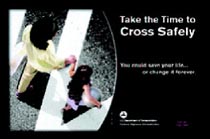 |
 |
 |
 |
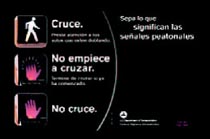 |
The files for all 8 Cinema Slides are located on Data CD1 in the folder FHWA CINEMA SLIDES on pages 2-9 of the Quark document FHWA CINEMA SLIDES-RGB.
Posters
Posters make great giveaways at events and can be distributed to department of motor vehicle offices, schools, religious organizations, health care offices and/or businesses.
In this kit, we have included electronic files for five posters. Each poster has been designed in color, but they may also be duplicated in black and white. If you would like to duplicate the posters in black and white, have a graphic designer convert the full color files into black and white files before sending them out for duplication. There are three small posters (11" x 17") and two large posters (24" x 36") that can be duplicated, offering you a choice to make based on your intended use.
If you're working with large spaces like blank walls, use the larger format. If you're placing them in a cluttered area, you will have to decide which size is best. While the large format is attention-getting, the smaller posters take up less room and may be more likely to stay up longer. When you place a large poster in an area that many people use to advertise, your poster may then be covered by others or removed. Most organizations/venues prefer that you ask for permission to put up posters before you post them. They may also have requirements about the materials you may use to adhere/attach them to surfaces.
You may have graphic designer or printing firm add your organization or coalition logo to the posters prior to duplication. The text "sponsor logo here" should be removed prior to duplication.
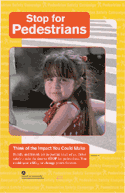 File is located on Data CD1 in the folder FHWA POSTERS/FHWA 11x17 POSTERS on page 2 of the Quark document GIRL_LOOKING_BACK_11x17. |
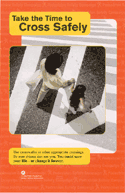 File is located on Data CD1 in the folder FHWA POSTERS/FHWA 11x17 POSTERS on page 2 of the Quark document AERIAL_MOM/GIRL_11x17. |
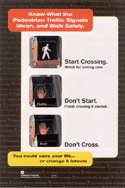 File is located on Data CD1 in the folder FHWA POSTERS/FHWA 11x17 POSTERS on page 2 of the Quark document SPANISH_SIGNALS_11x17 |
||
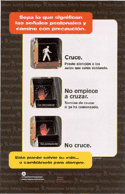 File is located on Data CD1 in the folder FHWA POSTERS/FHWA 24 x 36 POSTERS on page 2 of the Quark document TRAFFIC_SIGNALS_24x36. |
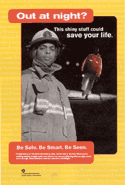 File is located on Data CD1 in the folder FHWA POSTERS/FHWA 24 x 36 POSTERS on page 2 of the Quark document REFLECTIVE_FIREMAN_24x36. |
|||
Brochures
The brochures provided with the campaign materials focus on pedestrian topics: reflective materials and pedestrian traffic signals. Research showed that the target audience wants brochures that are brief and concise. We have provided them in both English and Spanish for your adaptation and use. You can distribute them however you choose-direct mail, at fairs, shows or bazaars, in schools or office buildings, at theaters, performances, restaurants or bars. In many locations you will need to ask for permission to distribute literature.
Brochure 1
| Front | Back |
 |
 |
File is located on Data CD1 in the folder FHWA BROCHURES on pages 2-3 of the Quark document BROCHURE-REFLECTIVE.
Brochure 2
| Front | Back |
 |
 |
File is located on Data CD1 in the folder FHWA BROCHURES on pages 2-3 of the Quark document BROCHURE-SIGNALS.
Promotional Materials
You can enhance your campaign by producing promotional materials that communicate the pedestrian safety messages in a variety of ways. Artwork for your duplication and use in producing a variety of promotional materials is included on the campaign materials CDs.
Contact local vendors by looking in the business yellow pages under "Printers," "Promotional," "Advertising," or "Specialty Items." Suggested promotional materials include the following:
- Bumper stickers
- Doorknob hangers
- Flashlights
- Key chains
- Lanyards
- Letterhead
- Magnets
- Mousepads
- Mugs
- Pens/pencils
- Podium signs
- Program buttons
- Reflective materials (armbands, stickers, etc.)
- Stickers
- T-shirts
Obtain quotes from at least three companies before picking a vendor to produce these items. Also keep in mind that ordering a larger quantity will usually lower the "per unit" price. Be sure to inquire about these quantity price breaks.
All 14 images on this page are located on Data CD1 in the folder FHWA PROMO ITEM IMAGES in the Illustrator file PROMO_SLOGANS_PG1.eps. Individual JPGs of each image can also be found in the same folder on Data CD1 within the folder JPGS_PROMO_SLOGANS. The individual JPG name is listed below each image on this page.
|
|||||||||||||||
All 12 images on this page are located on Data CD1 in the folder FHWA PROMO ITEM IMAGES in the Illustrator file PROMO_SLOGANS_PG2.eps. Individual JPGs of each image can also be found in the same folder on Data CD1 within the folder JPGS_PROMO_SLOGANS. The individual JPG name is listed below each image on this page.
 |
 |
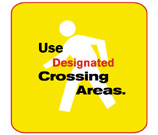 |
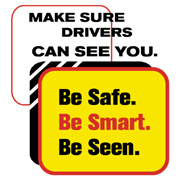 |
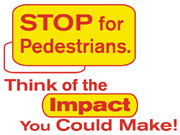 |
 |
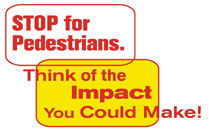 |
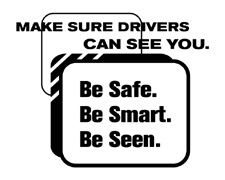 |
 |
 |
 |
 |
Technical Preparation of Media Materials
This kit includes everything you need to duplicate the Pedestrian Safety Campaign materials.* You will probably need several vendors to reproduce the various components. Carry this Step-by-Step Guide with you to discuss duplication options with potential vendors (found in telephone directories under "Communication and Media" or "Video" or "Production").
For the print pieces (PSAs, posters and brochures), a graphic designer or printing firm can help you add your coalition or supporting organizations' logo prior to duplication. They can also help if you need any of the files converted to black and white. For the television PSAs, you will need the help of a video editing studio. We do not recommend that you make any changes to the radio PSAs as the voiceover and music are "mixed." However, you can make duplicate copies. Please see below.
On many items, additional language can be added that is specific to the needs of your campaign, for example, a statistic such as: "Last year in Anytown, 7 pedestrians were killed. We need everyone's help to keep our pedestrians safe."
Here are a few additional recommendations:
Print Materials (PSAs, Posters and Brochures)
The print elements of this campaign can be duplicated in either black and white or full color. Directions for printing the PSAs, posters and brochures, along with instructions for customizing each piece with your coalition or supporting organizations' logo, are located on CD1, page one of the Quark document for that electronic file.
Television PSAs
The television PSAs included in this kit are on a broadcast-quality beta tape, which you can take to most television stations for airing. If you need to make copies, please request that the "Closed Captioning" and "Sigma Encoding" from the master be transferred to the copies. If the video production facility does not understand these technical terms, you may want to find a different facility. For information about TV PSA monitoring services, please see page 27. Electronic versions are available on CD2.
Radio PSAs
To make copies of the radio PSAs, you may take the enclosed audio CD to a CD duplication facility (found in telephone directories under "CD Duplication"), or ask a local radio station if they can make copies for you. If you have a CD burner, you can copy the CD using your own computer. However, do not compress the files, copy them as is.
Cinema Slides
Instructions for customizing the cinema slides with your coalition or supporting organizations' logo and saving your new files for cinema distribution are located on CD1, page one of the Quark document FHWA CINEMA SLIDES-RGB.
* Never send out your only copy of the enclosed CDs. Make duplicate CDs for any vendor involved in reproduction/duplication. If you lose your CDs, contact Tamara Redmon. See contact information on page 1.
Media Kit Materials
News Releases and Articles
If you have a media professional, public relations specialist or good writer in your coalition, you may want to develop your own news releases and articles for distribution to print and electronic media. A sample news release and news article are included in this planner and additional articles and releases are included on the enclosed Data CD2. You should use these articles and press releases as inspiration, and a formatting template, for your own documents.
There are a variety of venues for your original news articles. Some newspapers do accept pre-written articles-especially if they are submitted by a prominent member of the community. Consider asking a high-ranking public official to "byline" your article for the local general newspaper or a well-known business leader to "byline" an article for the local business journal.
Newsletters-both hard copy and electronic (email and web versions)-are also terrific vehicle for your news article. Look for organizations with a safety, health or education-related focus, such as the local hospital, parent-teacher organization, or apartment/townhouse/condominium community organization. Corporations with a commitment to the community might run an article in the company newsletter. And do not forget small clubs and organizations like the local Boy Scouts, Rotary Club or fitness center. Often, small organizations with newsletters are looking for content.
FOR IMMEDIATE RELEASEDate here |
FOR MORE INFORMATIONName here, Campaign Coordinator |
Anytown Launches Pedestrian Safety Campaign
Anytown, State*-(Coalition/Campaign Coordinator's organization name), public officials, local law enforcement and the general public are coming together to raise awareness about pedestrian safety. On (kick off event date here), Mayor Jane Smith and other officials will host a press conference at (time of day here) at (noteworthy intersection or City Hall address here). During the event, Mayor Smith will officially declare (campaign dates here) Anytown Pedestrian Safety Day/Week/Year.
Sponsored by (Coalition/Campaign Coordinator's organization name), Anytown Pedestrian Safety Day/Week/Year is a comprehensive campaign to promote pedestrian safety and educate the public about important pedestrian facilities designed to protect both drivers and pedestrians. These devices include crosswalks, pedestrian traffic signals, and pedestrian warning signs. Campaign materials will be unveiled at the press event, including television, radio and print public service announcements (PSAs), school posters, and more. The campaign targets both drivers and pedestrians.
According to (name of official), "On a national basis, over 5,000 pedestrians are killed, and 85,000 pedestrians are injured in roadway accidents every year, resulting in $20 billion societal costs. That's 200 pedestrians killed or injured every day. Locally, (list local statistic here). So it's a problem everywhere. This information is timely and much needed."
"Pedestrian safety is a two-way street that requires awareness for both pedestrians and drivers," says Campaign Coordinator (individual's name here). "This campaign addresses both of those audiences," he/she added. Materials include four television PSAs, six radio PSAs, 15 print PSAs, five posters, eight cinema slides, and two brochures. Many of the materials are bilingual.
Based upon research conducted for the campaign, producers created PSAs with emotional appeal. Two of the TV spots target drivers with a message to stop for pedestrians. One of those spots involves an adorable five year-old girl who is almost struck by a car while walking with her mother in a crosswalk. (With a stunt driver behind the wheel, none of the actors were in any danger.) Another spot shows a ten year-old girl at an intersection holding a photo of her mother. She tells viewers her mother was killed while trying to cross the street safely and asks who will take care for her now. Two of the TV spots target pedestrians. One shows how wearing reflective materials will help drivers see pedestrians in the dark. The other tells viewers to obey pedestrian traffic signals and watch for turning cars.
The campaign materials were designed to complement each other and all have a similar look and feel. The TV spots, print PSAs, posters and brochures have a de-saturated palette, with just the central character in vivid color, and the TV and radio spots all use the same music.
For more information, please contact
(Campaign Coordinator's name here)
at (phone number) or (email address).
* Use official US post office state abbreviation, e.g. AK, CA, IL, MT, NE, etc. (list only the city for top cities, such as Chicago, Los Angeles, Miami, New York, and Washington)
This and other newspaper articles can be found on Data CD2 as Newspaper Articles.doc.
Newspaper Article 1: General Pedestrian Safety
Anytown - The latest traffic safety report reveals that last year, 13 Anytown pedestrians were killed and many more were injured in motor vehiclepedestrian crashes. Per capita, those figures are slightly higher than the national average.
Nationally, it's estimated that 5,000 pedestrians are killed and 85,000 pedestrians are injured each year. During the last decade, more than 63,000 pedestrians died and more than a million others were injured in pedestrian-vehicle crashes. Of the people killed, 60 percent were working adults, 23 percent were seniors aged 65 or older, and 17 percent were children under 21.
Clearly, children and seniors are at highest risk. In Anytown, seven children died and at least 37 were injured while walking last year. Meanwhile, four of our seniors were killed and at least 24 injured as a result of vehicle-pedestrian crashes.
Experts say many of these crashes are due to unsafe behaviors by both pedestrians and drivers. So to address the problem, government officials, law enforcement, educators, local businesses, and parents have teamed up to raise awareness about pedestrian safety. Over the next six days/ weeks/months, members of the Anytown Pedestrian Safety Coalition will be conducting a public education campaign to raise awareness about ways to make walking safer for everyone.
The campaign is targeted to both pedestrians and drivers, and includes information designed to enhance pedestrian safety; such as crosswalks, pedestrian warning signs, pedestrian crossing signals, and reflective materials for nighttime visibility.
For pedestrians, a series of public service announcements (PSAs) encourage everyone to cross safely: use crosswalks, cross at the corner, or cross at other designated crossing areas; obey pedestrian crossing signals; and wear reflective materials when walking at night.
A series of PSAs urges drivers to look for pedestrians and stop for them. The series highlights a variety of situations, including the need to look for pedestrians in crosswalks and other designated crossings, as well as at all intersections; to remember to look for pedestrians when turning; and to keep in mind that when a car is stopped ahead of you, there may be a pedestrian crossing.
Nighttime visibility is one of the most important pedestrian safety issues covered. National statistics show that almost fifty percent of pedestrian fatalities occur between the hours of 6:00 p.m. and midnight. So the campaign includes PSAs and events to encourage schoolchildren and the public to carry a flashlight and wear reflective materials when walking at night.
Local police say the overall campaign is much needed. "I've seen so many near misses where a pedestrian crosses the street wherever they like, not looking for turning vehicles," says Officer Jack Delvan. "On the other hand, we've also had a few fatalities and many injuries because drivers are in a hurry, they're turning and they look for cars, but forget to look for pedestrians," Delvan added.
The Anytown Pedestrian Safety Coalition is currently conducting a campaign to remind drivers to look for pedestrians; and to encourage pedestrians to use crosswalks and follow the pedestrians crossing signals.
Information about these issues and more is available in both English and Spanish. To volunteer or obtain more information about Anytown's Pedestrian Safety Campaign and other associated events, please call (Campaign Coordinator's name here) at (phone number) or (email address).
Research and Methodology
Identifying the target audience(s) is the first step toward designing a successful marketing campaign. FHWA designed the Pedestrian Safety Campaign based on research. The first step was to convene a Technical Working Group (TWG) composed of engineering, enforcement, health, education and traffic safety experts representing various disciplines from around the United States. During the course of the project, the TWG met three times. At the first meeting, the group addressed their main objectives, which included: sensitizing drivers to pedestrians' rights to the road; educating pedestrians about minimizing their risks; and developing program materials to educate pedestrians and drivers about engineering safety countermeasures. In the first meeting the target audiences were also identified: young drivers and working-age pedestrians. Targeting these audiences would have the largest impact on the pedestrian safety problem. Young drivers cause a disproportionate number of crashes. Pedestrians are a varied group; working age adults are captured in this audience, as are parents of young children and older adults.
Over one hundred pedestrian safety-related campaign items were collected from 16 states and national campaigns as research material for the Pedestrian Safety Campaign . These items were each individually reviewed by Communications Specialists and catalogued. These materials were reviewed and analyzed, and some common themes were identified and taken into consideration as new materials were developed for this campaign. Furthermore, some of the materials were shown to focus groups and evaluated by target audience members. Of the 108 items, 13 were videotapes containing television PSAs; 39 were brochures, booklets or leaflets; and eight were posters. In addition, there was a slide presentation, yard signs, newspaper articles, buttons, a newsletter, some Spanish-language materials, a zipper pull, wallet card, and a variety of other materials.
The TWG generated multiple ideas for campaign concepts and taglines during the first meeting. In addition, eight focus groups were conducted during the course of the project. Four groups were held with drivers and four with pedestrians. Groups were held with drivers and pedestrians in order to assess their differing perspectives, motivations, concerns, and preferences. The groups yielded a great deal of valuable information and were a guiding force throughout the campaign development process. Numerous taglines, concepts, themes, and creative approaches were tested with the focus groups. Their detailed comments and suggestions shaped the campaign materials. For example, the drivers asserted that children get their attention and that they drive more cautiously around children. The drivers and pedestrians both thought that pedestrian injuries and fatalities are a serious issue that should not be treated lightly - they did not like humorous approaches. All of the pedestrians indicated feeling afraid while walking. They were all fearful of being hit by a car. Furthermore, all of the pedestrians could recall "close calls" with a vehicle, and one even reported being hit by a car.
The TWG was re-convened after the first six focus groups had been conducted. The research results were reported to the TWG, as well as the themes, slogans, and materials that FHWA developed as a result of the research participants' input. The creative materials were further refined based on the TWG's feedback and were tested again with focus groups of drivers and pedestrians.
Finally, all of the research was compiled: the focus group recommendations, the TWG recommendations, and the quantitative information concerning pedestrian crashes. Then the concepts were further refined and the ones deemed most effective were selected for production.
Subsequent to the production of the television and radio PSAs, the TWG met for a final session. The group reacted positively to the four television PSAs and offered valuable insight into refining the radio and print PSAs prior to final production. They also offered their suggestions for the construction of the Pedestrian Safety Campaign Planner. The group strived to attain the same "look and feel" throughout the campaign materials.
Research Summary - Key Points
Target Audiences
- Young drivers
- Working-age adult pedestrians
Key Issues (Based upon data supplied by NHTSA):
- Drivers yielding to pedestrians in unmarked crosswalks
- Drivers yielding to pedestrians when making a right or left turn in a signalized crosswalk
- Pedestrians understanding the meaning of the "Walk" and "Don't Walk" signals
- Pedestrians understanding the need to be visible, i.e. wear reflective materials
Focus Group Recommendations for Production:
- Make sure the spots have emotional impact as opposed to humor
- Use visuals of children
Desired Outcomes for the "Driver" Targeted Spots:
- More drivers stay alert when approaching intersections
- More drivers yield to pedestrians in crosswalks
- The spots teach people to appropriately identify pedestrian crossing signs
- The spots educate people about what the pedestrian crossing signs mean
Key Messages for the "Driver" Targeted Spots:
- Stay alert at ALL intersections
- Yield to pedestrians in the crosswalk
Desired Outcomes for the "Pedestrian" Targeted Spots:
- More pedestrians use the crosswalks and watch for turning vehicles
- More pedestrians are educated about the meanings of pedestrian signals
- More pedestrians are educated about the need for improving their visibility to drivers at night
Key Messages for the "Pedestrian" Targeted Spots:
- Follow the pedestrian signals
- Make yourself visible at night with reflective materials and a flashlight
- Use crosswalks and look for vehicles while crossing
Other Resources/Relevant Links
For pedestrian-related information, please visit:
https://www.fhwa.dot.gov/safety/pedestrian-bicyclist or
http://www.walkinginfo.org/
Public Information Officers listed by state:
http://www.dot.state.ia.us/ntpaw/piolist.htm
Pedestrian and Bicycle Coordinators listed by State:
https://www.fhwa.dot.gov/environment/bicycle_pedestrian/state_contacts.cfm
This newspaper article appeared in the Montgomery County, MD Bethesda Gazette following the TV PSA filming.
Pedestrian safety campaign filmed in Bethesda
by Catherine Dolinski
Staff Writer
Aug. 14, 2002
A silver sedan narrowly missed hitting a woman and a 5-year-old girl as they crossed the street at the corner of St. Elmo and Norfolk avenues in Bethesda on Tuesday.
Minutes later, as the woman and girl crossed at the same crosswalk, the same car nearly clipped them again.
The same thing happened again 15 minutes later - and then again.
But no one was injured, as it was all arranged before cameras as part of a public service campaign to raise awareness about the importance of pedestrian safety.
Film crews from Atomic Dog, a production company in Washington, D.C., trucked in cranes, cameras, lights and actors into downtown Bethesda Tuesday to begin shooting the first of four pedestrian safety spots for the Federal Highway Administration. The 30- to 60-second public service announcements, to be broadcast nationwide on television this fall or winter, highlight the responsibilities that drivers and walkers share in guarding against accidents.
Janet Coleman, the administration's director of safety programs, said while the number of pedestrian fatalities nationwide dropped by 27 percent in 2000 to 4,739 from the 6,482 reported in 1990, the agency is committed to making more progress. "We'll never be satisfied until we have zero pedestrian fatalities," she said.
In the spot filmed Tuesday, actress Rahaleh Nassri of Washington, D.C. looks both ways before crossing Norfolk Avenue, holding the hand of 5-year-old Monica Garza. Halfway across the crosswalk, however, Nassri drops her floral shopping bag and grabs the little girl just in time, who screams as a silver Chrysler Concorde appears to nearly hit them while turning.
 |
Actress Rahaleh Nassri of Washington, D.C. pulls back 5-year-old Monica Garza of Charles County Tuesday during filming of a pedestrian safety public service announcement at the intersection of St. Elmo and Norfolk avenues in Bethesda. Stunt actor Sean Kelly of Glen Echo was behind the wheel of the car, and the actors were not in danger. Laurie DeWitt/The Gazette |
"Mmm, that was a little close," said Joyce Garza of Charles County, watching nervously from the sidewalk as her daughter Monica rehearsed the near-accident. "They had not told me about this until about 15 minutes ago. The only thing we knew was that there would be an intersection scene. Monica's pretty fearless, though. The only thing that concerned her was that she'd have to drop the ball she's holding."
Stunt actor Sean Kelly of Glen Echo, who was behind the wheel of the silver Chrysler, said the spot was being choreographed carefully, as neither Garza nor Nassri are stunt actors. "It's incredibly safe, but we're making it look terribly scary," said Kelly, who has appeared in numerous films and TV shows, including "The Wire" on HBO. "Bryan [Elsom, the director] will use camera angles from behind the actors and from the point of view of the driver to create the effect."
A few yards off, Montgomery County Police Lt. Harold Allen said the near-miss scene was all-too realistic. "It's a real problem, a very legitimate scenario they've set up," he said. "People get too distracted."
Emotional appeals
This afternoon, the crew is filming the second spot at Norfolk and Cordell avenues, in which a 10-year-old girl stands by a street holding a picture of her mother. The girl tells viewers her mother died in a car collision, and asks who will take of her now.
"These are all emotional appeals," said Susan Yates, account manager for LISBOA Inc., the communications firm hired by the Federal Highway Administration to coordinate the $50,000 safety campaign. When completed the campaign will include print and radio materials as well.
"We started at first with the idea of using animation or being funny, but the [test] audiences hated it,"Yates said. "They were very direct about wanting emotional impact."
The third spot, which features equipment from Bethesda-Chevy Chase Rescue Squad, will be filmed tonight at the intersection of Battery Lane and Keystone Avenue. In it a firefighter speaks about the importance of wearing reflective clothing both on and off the job. The fourth spot will combine footage from the other three.
Atomic Dog producer Dana Voorhees said filming downtown required coordinating with a myriad of local entities in addition to the police department, including Bethesda Urban Partnership, the county executive, Bethesda-Chevy Chase Rescue Squad and others.
But that "rigmarole" was worth being able to film locally, said Carol Flaisher, an independent production manager hired for the project, and a resident of Cabin John.
"As soon as I found out what we were looking for, I told [Elsom], this is the place," she said. "Bethesda's a city, but it's not too urban. It's attractive, but not too recognizable. It could be Any City, USA."
Elizabeth Lisboa, owner of LISBOA Inc., agreed. "I've been here for 20 years," she said. "This is such a great neighborhood. It's so great to be able to bring business to Bethesda."
Cautious business owners
Not all local business owners were quite so enthusiastic, however. Young Kim, owner of Temptationz Café at the corner of Norfolk and St. Elmo's, said he hoped the project would attract the interest of passers-by, but worried the crews and traffic restrictions would block access to his restaurant.
"I'm a little bit concerned," he said, looking out of his window. "I guess as long as they don't completely block the street, it'll be OK. They said if I lose a lot of business they'll write me a check for it. ... But if they completely block things off, it won't be just me who's affected."
Flaisher said keeping local businesses happy during the shoot was a challenge. "What usually happens is that it's fun, a local morale booster - as long as no one gets interrupted," she said. "We want to make sure we can come back here; it's a trust factor."
Across Norfolk Avenue, La Miche restaurant co-owner Jason Tepper was happy to rent out his private dining room for use as a costume and prop area. "It's a great cause, pedestrian safety," he said. "I guess we're lucky we're in such close proximity to participate."
Road access around the filming sites was restricted at times Tuesday, but fully blocked off only for short intervals while the stunt car was in use. Less restriction is expected for today's shoots. Some parking around the film sites have been reserved with bagged parking meters, at the Federal Highway Administration's expense.
Allen was one of several off-duty Montgomery County Police officers hired to control traffic around the sets, and ensure security. As he waved cars past the set on Tuesday, he reflected on the poor judgment displayed by people crossing the street nearby.
"Safety is a two-way street," he said. "There'll be a safe crosswalk within 50 yards of people, and they'll cross right in the middle of the street. Just look at that woman down there," he said, nodding in the direction of a woman crossing the middle of St. Elmo's Avenue. "They just don't get it. You've got to start educating people. This is a good start."
Life in the Crosswalk
by Tamara Redmon and Leverson Boodlal
Public service announcements, demonstration projects, and a university course are key components of a new FHWA push to improve pedestrian safety.
"In the time it takes to stop for someone in the crosswalk, you could save a life - or change yours forever.
" Extracted from a radio public service announcement (PSA), this compelling reminder for motorists to brake for pedestrians in crosswalks lies at the heart of a new Federal Highway Administration (FHWA) drive to generate awareness among drivers and highway designers about the importance of pedestrian safety.
On average, a pedestrian is killed or injured in a traffic crash every 7 minutes. In the past, FHWA concentrated most of its safety resources on improving the roadway-driver environment more than the pedestrian environment. However, with pedestrians accounting for approximately 11 percent of roadway fatalities each year, the agency has modified its approach, and more effort and funding have been forthcoming in recent years to safeguard walkers and bicyclists. In fact, reducing pedestrian fatalities and injuries now is one of the FHWA Safety Office's top priorities and is part of the safety-related objective in FHWA's Vital Few goals.
More than simply providing highway engineers with the tools and resources they need to improve the roadway environment for foot and bike traffic, FHWA's approach now includes education and outreach, with a three-pronged strategy: (1) educating the public about safe pedestrian behavior, (2) getting drivers into the habit of watching for and yielding to pedestrians, and (3) ensuring that engineers and planners accommodate for nonmotorized traffic when they design roadways and other transportation facilities.
Among FHWA's ongoing tactics are an outreach campaign that includes television and radio PSAs, a demonstration program that will test and evaluate pedestrian safety countermeasures, and a new university course on designing pedestrian and bicyclist facilities.

Tree-lined streets, shops with outdoor seating, and wide sidewalks are among the features that contribute to mixed-use development.
Outreach Campaign
The idea for a pedestrian safety outreach campaign stemmed from a vision of persuading people to think about safety as they go about their daily lives. The threefold purpose of the campaign is to (1) sensitize drivers to the fact that pedestrians are legitimate road users and should always be expected on or near roadways, (2) educate pedestrians about minimizing risks to their safety, and (3) develop program materials to explain or enhance the operation of engineering measures such as crosswalks and walk signals.
Working with a limited budget, FHWA elected to develop a ready-made toolkit of outreach materials that States and communities could customize and use locally. The toolkit includes materials designed for use on television and radio and in cinema and print advertising. States and communities take responsibility for contacting local television and radio stations and print media to place the PSAs. FHWA also is developing a strategic planning guide that explains how to implement the campaign successfully at the local level.
Mustering a Team
From past experience, FHWA's pedestrian safety team knew that it would need the buy-in of the potential stakeholders in order for the campaign to move forward. In the early stages, FHWA formed a technical working group consisting of representatives from State departments of transportation (DOTs), the National Highway Traffic Safety Administration (NHTSA), FHWA field and resource center offices, and experts from the health, education, law enforcement, public relations, and transportation disciplines. The technical working group met in Washington, DC, on three occasions during the year that it took to develop the campaign.
 Adult and child actresses approach a crosswalk in Bethesda, MD, as a film crew records video footage for a new FHWA public service announcement (PSA) educating drivers on pedestrian safety. |
 This aerial shot of a parent and child in a crosswalk in one highlight of a new FHWA television PSA that helps remind drivers to watch for pedestrians in crosswalks when making turns. |
 Another FHWA PSA makes a hardhitting appeal to drivers to look out for pedestrians because the lives of children - and, in this case, the dead mother whose photo is held by her daughter - are in their hands. |
Making an Impact
With so many messages bombarding the public in daily life, one of the greatest challenges in developing the outreach campaign was deciding on themes and messages. In addition to capitalizing on the expertise brought to the table at the meetings of the technical working group, the team also hosted eight focus group meetings in Washington, DC; Chevy Chase, MD; and Los Angeles, CA.
Focus groups typically contain about 10 participants and are intended to provide insight into the thinking of an average member of the public. Although not statistically significant, focus groups can provide useful attitudinal and behavioral information, specifically regarding factors that influence both driver and pedestrian behavior. The findings from the focus groups indicated that (1) drivers are most influenced by the thought of hurting or killing a child; (2) both drivers and pedestrians want messages that appeal to them emotionally and are jarring, not anything humorous; (3) both drivers and pedestrians want to see and hear an actual crash in any video materials, as well as the aftermath.
The television spots focus on the meaning of the pedestrian signals and the importance of pedestrians making themselves visible at night. The driver spots have a strong emotional appeal. In one spot, for example, the camera cuts from the image of a mother and child walking to that of a driver about to make a left turn. As he drives down the road, various thoughts pass through his head: I'm a safe driver . . . I watch for cars . . . I pay attention . . . An image of the pedestrian crossing sign and the pedestrian signal pop into view, as does the image of the traffic signal on green. The driver makes a left turn not noticing the pedestrians in the crosswalk. The driver slams on the breaks and stops inches from the child, who is swooped out of harm's way by her mother. The driver, who appears completely shaken, gets out of the car and lets out a deep breath. The last image is of the child continuing to cross. She turns to look behind her, making eye contact with the TV viewer as if to say, "You could have hurt me."
 The well-trodden path that continues where the sidewalk ends provides evidence that pedestrians continue to use this route. Designers should look for such clues when considering locations for infrastructure improvements for foot traffic. |
The other driver-focused spot shows haunting images of a 10-year-old girl standing on a street corner holding a framed photo of her mother who was killed crossing the street. As other pedestrians pass her, she holds the photo up to them as they ignore her. She silently appeals to drivers to look for pedestrians and stop for them. The radio spots were more challenging to make, lacking the visual images that were so effective in the television PSAs. All the radio spots target drivers. Four of the six feature an actual crash, complete with muted sound effects. Five have a heavy emotional appeal, while the last one features a pedestrian offering to compromise with drivers. "I'll watch out for you and cross the street safely," says the pedestrian. "You watch out for me and stop. Think of the impact we can make."
Selecting Locations And Actors
After developing, testing, and revising the campaign themes and messages, the team agreed on the framework for the television PSAs and began searching for the ideal intersection to film. Potential locations needed to have well-marked crosswalks, correct pedestrian signals, and good sidewalks and curb cuts. The team looked for an urban or suburban setting in the Washington, DC, area and finally settled on two intersections in Bethesda, MD. Since the crosswalks were not well marked, the Montgomery County government quickly stepped in to provide high-visibility crosswalk markings at both locations.
Selecting actors also was a key component. Professional actors played the parts in the driver targeted PSAs, but one of the pedestrian PSAs - which focuses on the importance of wearing reflective clothing for visibility at night - takes place in a firehouse and features a volunteer firefighter.
In addition to the television and radio spots, the team also developed four pedestrian-targeted and four driver-targeted print PSAs and two posters. The campaign materials will be ready in their entirety by early 2003.
Pedestrian and Bicycle Crash Analysis Tool
 The opening screen in PBCAT prompts users to begin by selecting "Pedestrian crashes" or "Bicycle crashes" for analysis. |
Researchers at FHWA, in cooperation with NHTSA, developed the Pedestrian and Bicycle Crash Analysis Tool (PBCAT) to assist State and local coordinators, planners, and engineers with analyzing crashes and developing effective countermeasures.
By analyzing data from actual crashes, such as where and when they occurred, characteristics of the victims, and the sequence of events leading up to the crashes, the PBCAT software can produce tables and graphs illustrating the relationships among various crash types and other factors associated with the crashes (age, gender, light conditions, etc.). PBCAT also provides recommended countermeasures linked to specific pedestrian and bicycle crash types.
The PBCAT software and manual (FHWA-RD-99-192) are available at www.bicyclinginfo.org/bc/pbcat.htm. Carol Tan Esse
Creating a Pedestrian Environment
Creating a safe pedestrian environment involves more than laying down a sidewalk or installing a signal. A truly viable system is accessible to all pedestrians and starts with the a built environment that has destinations located close enough to each other for walking access; schools, parks, and public spaces sited appropriately; zoning that permits mixed-use developments; sufficient density to support transit; and commercial districts that people can access by foot. Thus, pedestrian facilities need to be planned, designed, operated, and maintained to be usable by all.
Traditionally, analyses of police crash reports provided the impetus for pedestrian safety improvements. Whether building new infrastructure or renovating existing facilities, planners and designers need to accommodate nonmotorized traffic. And methods should be identified to predict potential problems during the planning and design phases before crashes occur.
Safer JourneyEvery day, across the United States, pedestrians face similar challenges trying to get from place to place safely. Safety practitioners at FHWA recognized a need for an educational tool that could reach a broad audience of road users - from engineers and designers to the law enforcement community and educational institutions. In 2001, FHWA created an interactive CD-ROM and online tool called "Safer Journey" to meet this need. "Safer Journey" is an animated virtual journey that follows a 14-year-old as he embarks on a walking trip from his home to a soccer field and back. Along the way, he encounters typical pedestrian situations such as busy streets without sidewalks, mid-block crossings, intersections, bus stops, and shared-use paths. The latter part of the trip takes place after dusk to simulate nighttime issues. Throughout the trip, the user helps the youth make appropriate decisions and has the opportunity to learn more about pedestrian safety features. By the end of 2002, FHWA expects that at least eight States (California, Illinois, Indiana, Maryland, South Carolina, Tennessee, Virginia, and Texas) will have formed partnerships among FHWA and State departments of transportation and education to produce, market, and implement "Safer Journey" in classrooms. To date, "Safer Journey" has won three international awards from Omni Intermedia and the U.S. International Film and Video Festival, as well as commendations from State and local officials. FHWA is translating the "Safer Journey" materials into Spanish, and a version targeting bicyclists also is under development. Check out "Safer Journey" online at http://safety.fhwa.dot.gov/ped_bike/. |
Evaluating Countermeasures
 This hot dog vendor has taken up so much of the sidewalk that pedestrians may be forced into the road in order to get around the cart. |
Past research on pedestrian safety focused on evaluating individual countermeasures, but safety personnel at FHWA and elsewhere recognized a need to examine safety impacts from a systemwide approach. In response, FHWA launched the Pedestrian Safety Engineering and Intelligent Transportation System-Based Countermeasures Program (PSECP) to demonstrate and evaluate that kind of approach. The objectives of the PSECP are to reduce pedestrian crashes and pedestrian-vehicle conflicts and to demonstrate the program's portability to other jurisdictions.
FHWA organized the PSECP into three phases - problem identification, implementation, and evaluation. In 2001, FHWA solicited proposals nationwide for jurisdictions to identify local problem areas and indicate interest in participating in the program. Locations with a high number of pedestrian fatalities were prime candidates. FHWA ultimately selected Miami Dade, FL; Clark County, NV; and San Francisco, CA. Pedestrian fatalities accounted for more than 25 percent of traffic fatalities at each jurisdiction. The next step, phase 2, will involve implementing and evaluating selected pedestrian countermeasures at different zones within each site.
The PSECP project's unique features include (1) deploying common pedestrian safety countermeasures at each site; (2) using standardized performance measures; (3) employing a zonal process (that is, identifying a subset of locations containing pedestrian problems) for targeting pedestrian safety improvements; (4) analyzing crash types with a software program, Pedestrian and Bicycle Crash Analysis Tool (PBCAT), developed by FHWA and NHTSA; (5) using a geographic information system (GIS) to develop maps showing pedestrian crash densities, (6) applying conflict analysis techniques to predict pedestrian crashes, and (7) engaging an independent evaluator to produce a crosscutting and how-to manual.
Lessons learned to date indicate that effective pedestrian programs are based on strong partnerships, public participation, and sensitivity to community concerns. They require accurate data, demonstrate an understanding of demographics, and feature pedestrian-oriented development regulations. Engineering, enforcement, and education are all critical elements in an effective pedestrian safety program. Engineering solutions often involve a combination of treatments at any one site, and any program evaluations should review the individual treatments as well as examine area-wide effects for both safety and mobility. Strong management support also is key to ensuring a successful program.
As of the end of 2002, phase 1 activities for Miami Dade and Clark County were completed. San Francisco will complete phase 1 by March 2003.
University Course
After reviewing civil engineering and planning curricula at universities across the United States, safety professionals at FHWA discovered an absence of information on accommodating pedestrian and bicyclist issues. Many students graduate without having a working knowledge of how to integrate walking and biking facilities into the planning and design of roadways. When informal feedback from professors indicated a lack of time or inclination to generate their own materials, FHWA began developing a university course on pedestrian and bicyclist facility design.
Completed in 2002, the course material is intended for use in undergraduate- or graduate-level transportation planning and design curricula at universities and related institutions. The course provides current information on pedestrian and bicycle planning and design techniques, as well as practical lessons on how to increase bicycling and walking through land-use practices and engineering design.
Developed in coordination with professors, the course is designed to be modular so that faculty members can teach it as a complete full-semester course, in segments, or as topics extracted to incorporate into their own courses. FHWA also received input from industry, State and local jurisdictions, the American Association of State Highway and Transportation Officials, the Human Powered Transportation Committee of the American Society of Civil Engineers, and other transportation organizations.
An interdisciplinary team approach to planning and implementing bicycle and pedestrian programs helped create materials that can be used to train future transportation professionals representing a variety of disciplines, including planners, engineers, and landscape architects.
Course Components
One component of the course, the Student's Guide, has 24 modules arranged into three sections. The introductory section covers the history of nonmotorized transportation, current levels of bicycling and walking, and factors that influence the choice to bicycle or walk. The planning section provides lessons covering a range of planning issues, including crash types, local bicycle or pedestrian plans, travel in suburban communities, traditional neighborhood design, and local zoning and subdivision regulations. The design modules cover a range of issues in nonmotorized transportation design such as traffic calming, pedestrian accommodation at intersections, on-road bicycle facilities, and trail design.
The Instructor's Guide parallels the Student's Guide, providing goals and objectives for each lesson, activities and homework problems, and overheads for the instructor to use while teaching the course. The final components are scripted, 1-hour slideshows providing an overview of pedestrian and bicycle planning and design. To date, more than 90 professors have participated in workshops designed to introduce the course and materials. Gene Russell, professor emeritus of civil engineering at Kansas State University (KSU), attended an early workshop in 1999. "I could see right away that the materials would be excellent for a course," he says. "Whether you're teaching graduate engineering students or offering an elective course for professional development, the materials are flexible so you can use what you want and add your own supplemental materials."
Russell, who teaches a graduate version of the course, emphasizes the importance of teaching pedestrian facility design to new generations of engineers and designers. "Increasingly, communities and pedestrian advocates are putting pressure on engineers and policymakers to create more and safer environments for nonmotorized traffic, and we need to build them right," he says.
FHWA plans to continue promoting the university course nationwide. The course materials are available on the Web at http://safety.fhwa.dot.gov/ped_bike/univcourse. The Association of Pedestrian and Bicycle Professionals also has put together a task force to help promote the course.
The Road Ahead
Achieving FHWA's goal of reducing pedestrian fatalities and injuries requires a comprehensive program that touches on all aspects of the pedestrian safety problem. By employing innovative approaches to reaching out to roadway users and designers, FHWA can have the greatest impact. We will not be satisfied until there are no pedestrian fatalities and injuries.
Tamara Redmon is a transportation specialist in FHWA's Safety Office. She has worked for FHWA for 11 years and currently manages the pedestrian and bicyclist safety program. She has a B.A. in English from Virginia Polytechnic Institute and State University and an M.A. in human resource management from Marymount University.
Leverson Boodlal has more than 20 years experience in highway and transportation safety projects. He is a consultant to FHWA, currently serving as technical manager and developer on projects involving pedestrian and highway safety. He has a B.S. degree in civil engineering, an M.S. in transportation and traffic planning, an executive MBA, and he is a registered professional engineer.
For more information on pedestrian/bicyclist issues, please visit http://safety.fhwa.dot.gov/ programs/ped_bike.htm.

